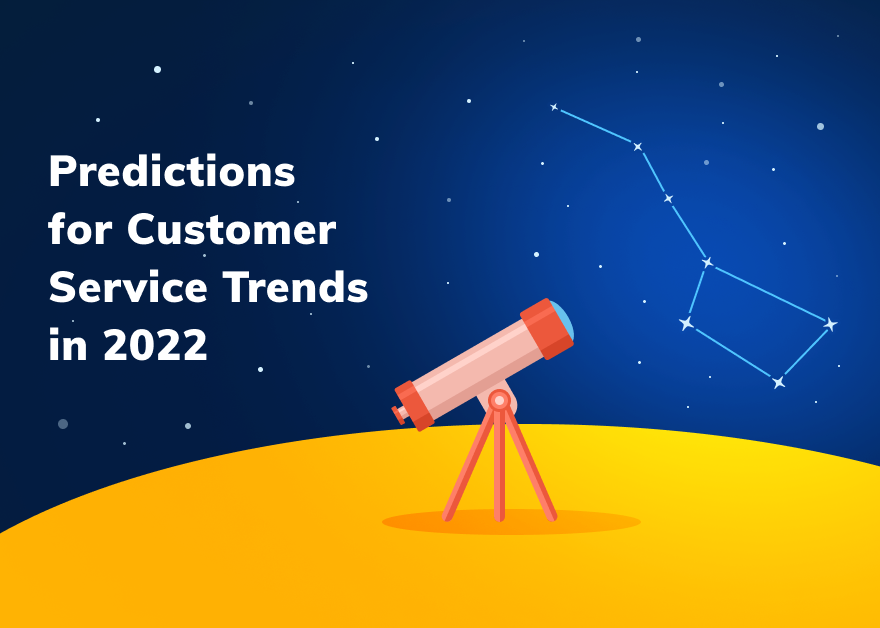As the globe shifts into a new year – and a new post-pandemic reality – consumer spending and behavior patterns are expected to change yet again.
While the movement toward consumer empowerment continues – what can we expect within this arena in 2022?
Let’s take a look at some of the trends we can expect to see within the customer service landscape and some of the changes consumers will be initiating.
Trend 1: Customer Service Becomes The Face of The Brand
In a world that continues to lean toward globalization and nonstop accessibility, brands are expected to offer 24/7 services and instant responses via social media channels.
From the rise in customer-centric rhetoric found within advertising campaigns to full-on teams embedded within social networks, we’ll see more companies prioritizing their efforts through customer service to become the brand’s face.
Trend 2: An Increase in Personalization with Customer Service
Consumers are becoming more attuned to personalization- in fact, more and more shoppers believe brands should tailor their marketing efforts to individual customers.
Within the customer service realm, we’ll continue to see companies recognizing this need and producing customized experiences for each individual.
What does this mean for consumers? We can expect to see more customized experiences, from highly personalized customer service responses to customized care plans – which could even include remote monitoring of health conditions.
Trend 3: The Rapid Growth of eCommerce
Over the last few years, many brands have turned to eCommerce as a customer acquisition and growth mechanism. It is predicted that more than 50% of all online transactions will be conducted via mobile devices, which means you can expect this trend of purchasing online – especially with mobile – to continue.
While this presents its challenges (customer service, shipping, and fulfillment), brands will need to work harder than ever to create an authentic experience during the online purchasing process, whether facilitated through email or social channels.
The rise of eCommerce presents new considerations regarding customer service, including how companies will meet the skyrocketing demand for immediate responses and personalized experiences.
Trend 4: Continued Focus On High Customer Service Expectations
Consumers will continue to expect faster and more transparent service from their favorite brands.
Expectations such as fast response times, convenient communication channels, and support systems will continue to be primary, as customers look to companies to take a leading role in ethics and social responsibility.
Aspects such as live chat – such as services provided by Provide Support – will lead the way in giving companies a personalized face that consumers can trust with their needs.
Trend 5: Enhanced Remote Customer Service
As customer service continues to happen remotely, there will be a growing demand for team collaboration tools. While this process is becoming more efficient, it still has challenges, including measuring team member performance.
As companies lean toward building remote teams- whether in outsourcing or hiring an international workforce- using up-to-date collaboration tools will become necessary to ensure optimal productivity and accountability across the board.
Tools such as Virola will impact how customer service reps communicate effectively in an ever-shifting landscape.
Trend 6: An Increased Focused on Talents Retention
Customer service teams must make a concerted effort to create a sense of community and authenticity. In a world where customer experience is becoming the face of brands, this will be key in how companies maintain their high standards- and retain top talent.
With technology advancing rapidly, customer service reps must be aware that they are part of a highly competitive landscape. Companies will need to create an authentic culture that breeds loyalty and pride for agents to avoid turnover.
Trend 7: More Bots in Customer Service Handling Human Tasks
We’ve already seen the rise of chatbots, which are increasingly being used to handle customer service inquiries via email and social media.
By 2021, experts predicted that customer service bots would be handling 85% of all interactions within eCommerce sites. Those stats have proven true – and beyond. This will continue to hold, especially if companies prioritize their customers’ experiences through personalized approaches.
The rise of chatbots will impact how companies approach customer service strategies- particularly in terms of their ability to provide customized experiences explicitly tailored to the needs of individual consumers.
However, chatbots can’t handle everything perfectly, so features such as live chat and phone support will continue to be essential components of customer service strategies.
Customer Service Stays Critical in 2022 and Beyond
In 2022, customer service will likely become more critical than ever in the continued success of businesses. As technology advances and companies begin to prioritize personalized experiences for consumers, providing a high level of customer service will only become increasingly essential to growing a brand.
And while human interaction is becoming increasingly less common in many consumer interactions, there will always be a need for an increased focus on customer service- whether this takes the form of chatbots, remote teams, or other tools.
Companies must continue to make lean investments in training new employees and retaining top talent to ensure that their services are up-to-date with the latest technology trends, industry best practices, and consumer needs.
- How Virola changes the way you Secure your Data - April 13, 2022
- Predictions for Customer Service Trends in 2022 - February 4, 2022
- 3 Tips for Running a Successful Online Business in 2022 - January 18, 2022

